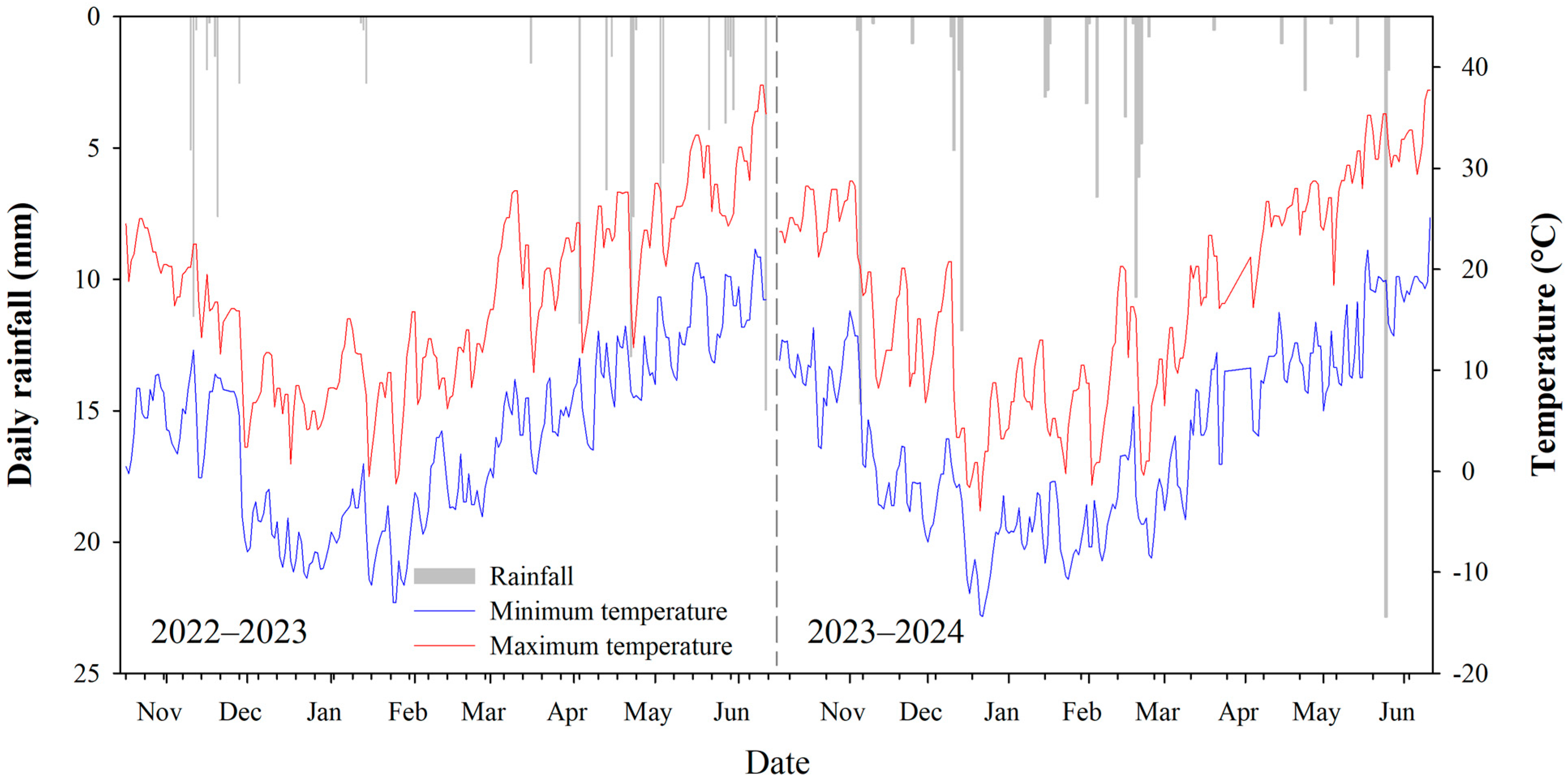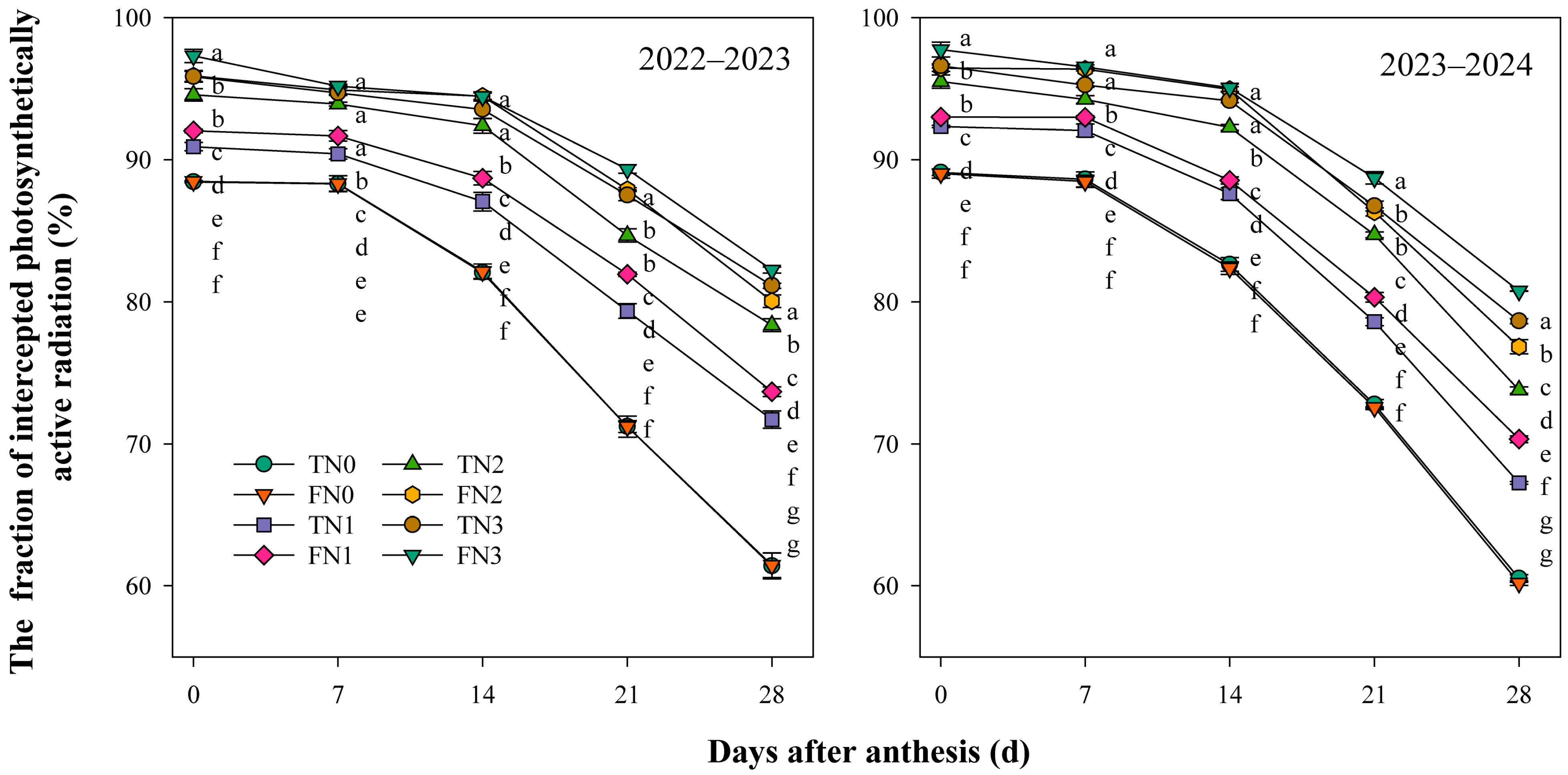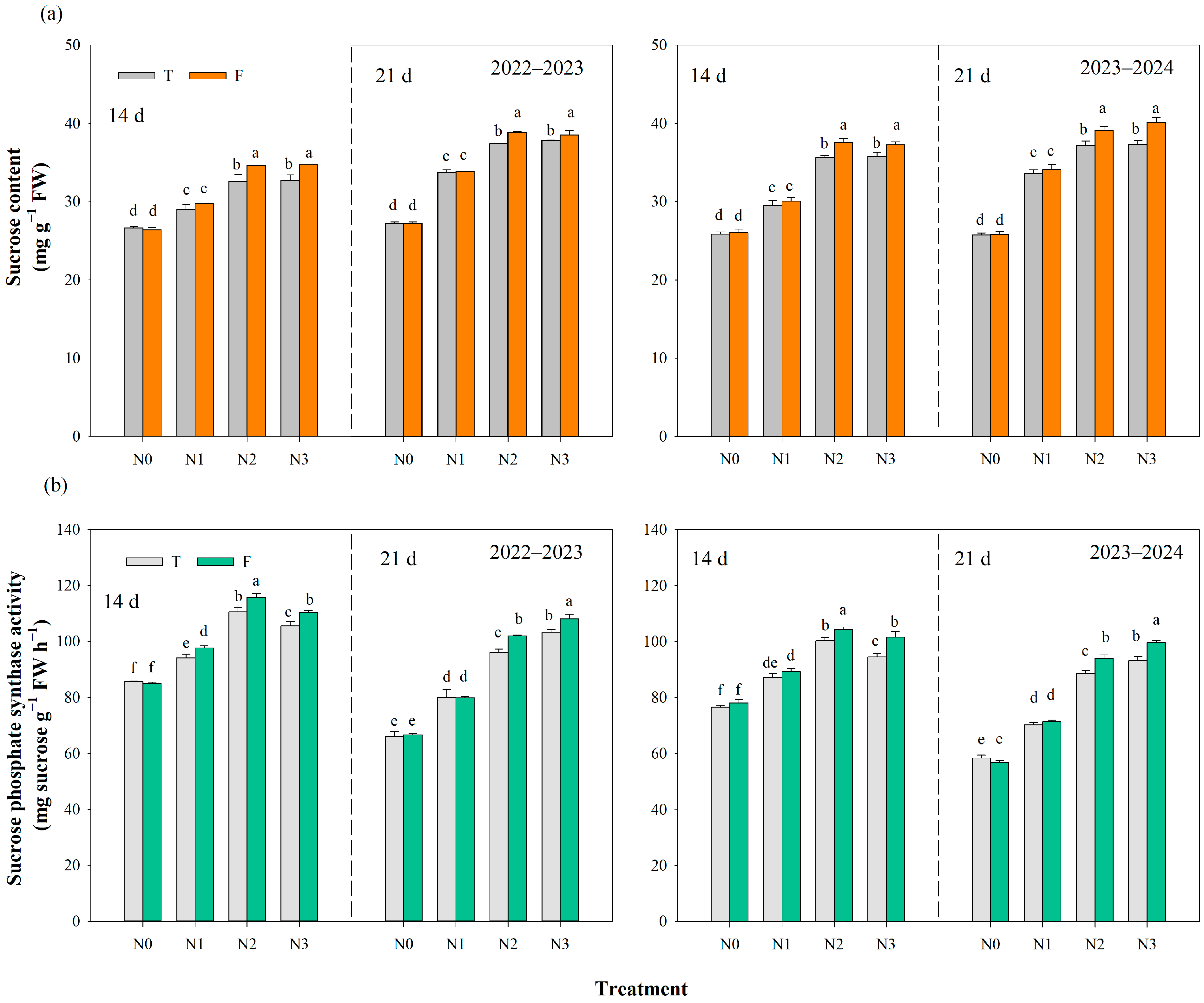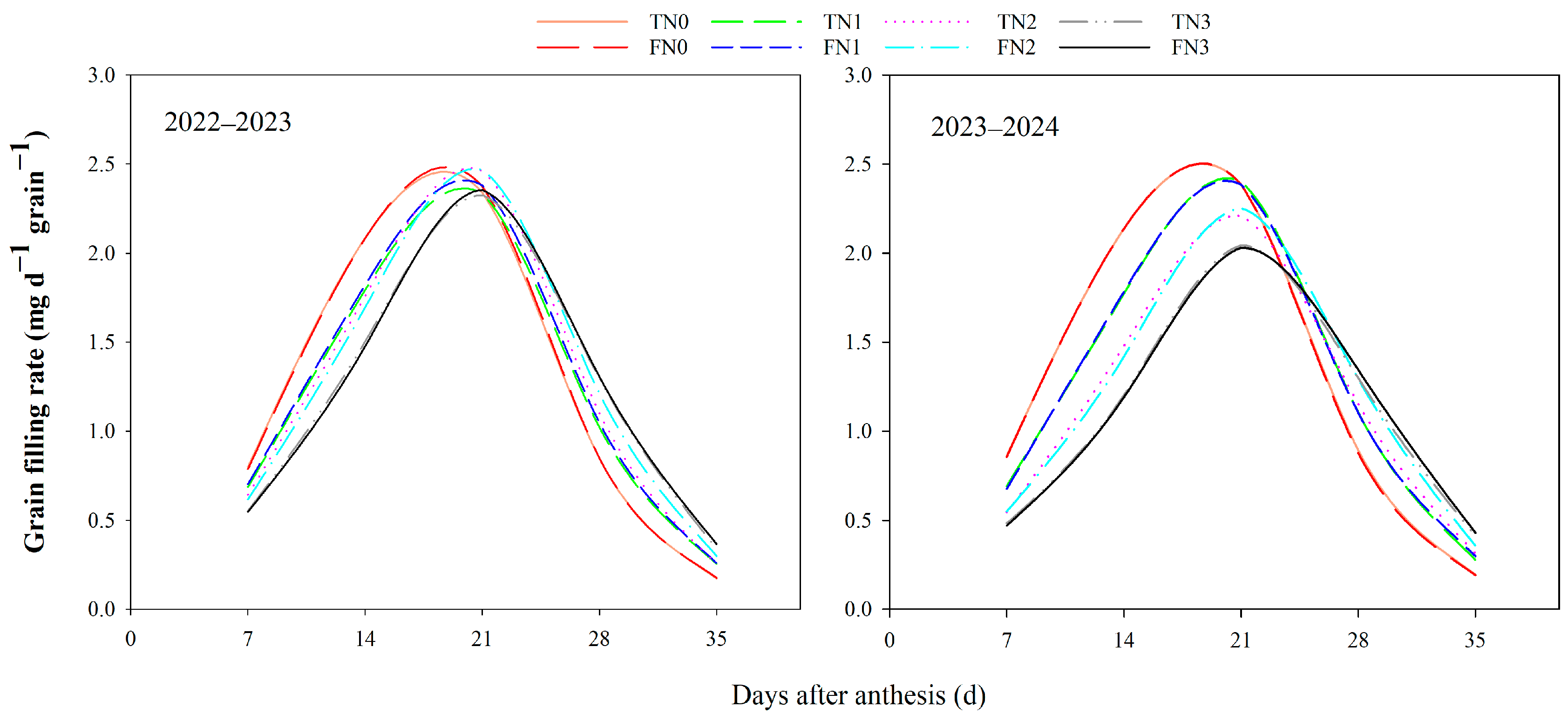Effect of Nitrogen Management Practices on Photosynthetic Characteristics and Grain Yield of Wheat in High-Fertility Soil
Abstract
:1. Introduction
2. Materials and Methods
2.1. Experiment Site and Design
2.2. Samplings and Measurements
2.2.1. Photosynthetically Active Radiation
2.2.2. Leaf Gas Exchange Parameters
2.2.3. Leaf Sucrose Content and Sucrose Phosphate Synthase Activity
2.2.4. Dry Matter Accumulation and Remobilization
2.2.5. Grain Filling Characteristics
2.2.6. Grain Yield, N Agronomic Efficiency and Water Use Efficiency
2.2.7. Data Statistics and Analysis
3. Result
3.1. The Effect of Different N Management Practices on Grain Yield
3.2. The Effect of Different N Management Practices on Canopy Photosynthetic Effective Radiation Interception Rate
3.3. The Effect of Different N Management Practices on Photosynthesis Characteristics
3.4. The Effect of Different N Management Practices on Sucrose Content and Sucrose Phosphate Synthase Activity in Flag Leaves
3.5. The Effect of Different N Management Practices on Dry Matter Accumulation and Remobilization
3.5.1. Dry Matter Accumulation at Maturity
3.5.2. Dry Matter Remobilization
3.6. The Effect of Different N Management Practices on Grain Filling Characteristics
3.7. The Effect of Different N Management Practices on N Agronomic Efficiency and Water Use Efficiency
4. Discussion
4.1. Canopy Light Interception and Photosynthetic Characteristics under N Management Practices
4.2. Dry Matter Accumulation, Remobilization and Grain Filling under N Management Practices
4.3. Grain Yield, N Agronomic Efficiency and Water Use Efficiency under N Management Practices
5. Conclusions
Author Contributions
Funding
Data Availability Statement
Acknowledgments
Conflicts of Interest
References
- Ma, M.Y.; Liu, Y.; Zhang, Y.W.; Qin, W.L.; Wang, Z.M.; Zhang, Y.H.; Lu, C.M.; Lu, Q.T. In situ measurements of winter wheat diurnal changes in photosynthesis and environmental factors reveal new insight into photosynthesis improvement by super-high-yield cultivation. J. Integr. Agric. 2021, 20, 527–539. [Google Scholar] [CrossRef]
- Liu, H.; Xiong, W.; Mottaleb, K.A.; Krupnik, T.J.; Burgueo, J.; Pequeno, D.N.L.; Wu, W.B. Contrasting contributions of five factors to wheat yield growth in China by process-based and statistical models. Eur. J. Agron. 2021, 130, 126370. [Google Scholar] [CrossRef]
- Yu, C.Q.; Huang, X.; Chen, H.; Godfray, H.C.J.; Wright, J.S.; Hall, J.W.; Gong, P.; Ni, S.Q.; Qiao, S.C.; Huang, G.R.; et al. Managing nitrogen to restore water quality in China. Nature 2019, 567, 516–520. [Google Scholar] [CrossRef] [PubMed]
- Omonode, R.A.; Halvorson, A.D.; Bernard, G.; Vyn, T.J. Achieving lower nitrogen balance and higher nitrogen recovery efficiency reduces nitrous oxide emissions in North America’s maize cropping systems. Front. Plant Sci. 2017, 8, 1080. [Google Scholar] [CrossRef]
- Hu, C.X.; Tian, Z.W.; Gu, S.L.; Guo, H.; Fan, Y.H.; Abid, M.; Chen, K.; Jiang, D.; Cao, W.X.; Dai, T.B. Winter and spring night warming improve root extension and soil nitrogen supply to increase nitrogen uptake and utilization of winter wheat (Triticum aestivum L.). Eur. J. Agron. 2018, 96, 96–107. [Google Scholar] [CrossRef]
- Shahrokhnia, M.H.; Sepaskhah, A.R. Effects of irrigation strategies, planting methods and nitrogen fertilization on yield, water and nitrogen efficiencies of safflower. Agric. Water Manag. 2016, 172, 18–30. [Google Scholar] [CrossRef]
- Tafteh, A.; Sepaskhah, A.R. Application of HYDRUS1D model for simulating water and nitrate leaching from continuous and alternate furrow irrigated rapeseed and maize fields. Agric. Water Manag. 2012, 113, 19–29. [Google Scholar] [CrossRef]
- Smith, E.N.; van Aalst, M.; Tosens, T.; Niinemets, U.; Stich, B.; Morosinotto, T.; Alboresi, A.; Erb, T.J.; Gomez-Coronado, P.A.; Tolleter, D.; et al. Improving photosynthetic efficiency toward food security: Strategies, advances, and perspectives. Mol. Plant. 2023, 16, 1674–2052. [Google Scholar] [CrossRef] [PubMed]
- Song, Q.; Su, R.; Chai, Y.; Goudia, B.D.; Chen, L.; Hu, Y.G. High photosynthetic capability observed in the wheat germplasm with rye chromosomes. J. Plant Physiol. 2017, 216, 202–211. [Google Scholar] [CrossRef]
- Plaut, Z.; Butow, B.J.; Blumenthal, C.S.; Wrigley, C.W. Transport of dry matter into developing wheat kernels and its contribution to grain yield under post-anthesis water deficit and elevated temperature. Field Crops Res. 2004, 86, 185–198. [Google Scholar] [CrossRef]
- Mu, H.; Jiang, D.; Wollenweber, B.; Dai, T.; Jing, Q.; Cao, W. Long-term low radiation decreases leaf photosynthesis, photochemical efficiency and grain yield in winter wheat. J. Agron. Crop Sci. 2010, 196, 38–47. [Google Scholar] [CrossRef]
- Tuncel, A.; Okita, T.W. Improving starch yield in cereals by overexpression of ADPglucose pyrophosphorylase: Expectations and unanticipated outcomes. Plant Sci. 2013, 211, 52–60. [Google Scholar] [CrossRef] [PubMed]
- Bahrani, A.; Abad, H.H.S.; Sarvestani, Z.T.; Moafpourian, G.H.; Band, A.A. Remobilization of dry matter in wheat: Effects of nitrogen application and post-anthesis water deficit during grain filling. N. Z. J. Crop Hort. 2011, 39, 279–293. [Google Scholar] [CrossRef]
- Wang, J.J.; Sun, X.; Hussain, S.; Yang, L.H.; Gao, S.S.; Zhang, P.; Chen, X.L.; Ren, X.L. Reduced nitrogen rate improves post-anthesis assimilates to grain and ameliorates grain-filling characteristics of winter wheat in dry land. Plant Soil 2024, 499, 91–112. [Google Scholar] [CrossRef]
- Roger, S.B.; Kindred, D.R. Analysing nitrogen responses of cereals to prioritize routes to the improvement of nitrogen use efficiency. J. Exp. Bot. 2009, 60, 1939–1951. [Google Scholar]
- Li, J.P.; Wang, Y.Q.; Zhang, M.; Liu, Y.; Xu, X.X.; Lin, G.; Wang, Z.M.; Yang, Y.M.; Zhang, Y.H. Optimized micro-sprinkling irrigation scheduling improves grain yield by increasing the uptake and utilization of water and nitrogen during grain filling in winter wheat. Agric. Water Manag. 2019, 211, 59–69. [Google Scholar] [CrossRef]
- Li, J.P.; Wang, Z.M.; Yao, C.S.; Zhang, Z.; Liu, Y.; Zhang, Y.H. Micro-sprinkling irrigation simultaneously improves grain yield and protein concentration of winter wheat in the North China Plain. Crop J. 2021, 9, 1397–1407. [Google Scholar] [CrossRef]
- Ju, X.; Xing, G.; Chen, X.; Zhang, S.; Zhang, L.; Liu, X.; Cui, Z.; Yin, B.; Christie, P.; Zhu, Z.; et al. Reducing environmental risk by improving N management in intensive Chinese agricultural systems. Proc. Natl. Acad. Sci. USA 2019, 106, 8077–8078. [Google Scholar] [CrossRef]
- Farmer’s Daily. The Background of Incessantly New Record in High Yielding Winter Wheat. Available online: https://szb.farmer.com.cn (accessed on 14 June 2019).
- Noor, H.; Yan, Z.; Sun, P.; Zhang, L.; Ding, P.; Li, L.; Ren, A.; Sun, M.; Gao, Z. Effects of Nitrogen on Photosynthetic Productivity and Yield Quality of Wheat (Triticum aestivum L.). Agronomy 2023, 13, 1448. [Google Scholar] [CrossRef]
- Zhang, Z.; Mao, X.M.; Zhong, W.W.; Feng, Z.B.; Zhou, X.B. Photosynthetic production of wheat under precision planting patterns in Northern China. Biosci. J. 2017, 33, 1–9. [Google Scholar] [CrossRef]
- O’Connell, M.G.; O’Leary, G.J.; Whitfield, D.M.; Connor, D.J. Interception of photosynthetically active radiation and radiation-use efficiency of wheat, field pea and mustard in a semi-arid environment. Field Crops Res. 2004, 85, 111–124. [Google Scholar] [CrossRef]
- Cabrera-Bosquet, L.; Albrizio, R.; José, L.A.; Salvador, N. Photosynthetic capacity of field-grown durum wheat under different n availabilities: A comparative study from leaf to canopy. Environ. Exp. Bot. 2009, 67, 145–152. [Google Scholar] [CrossRef]
- Chantal, F.; Jaleh, G.; Gabriel, C. Drought effect on nitrate reductase and sucrose-phosphate synthase activities in wheat (Triticum durum L.): Role of leaf internal CO2. J. Exp. Bot. 2007, 58, 2983–2992. [Google Scholar]
- Chu, P.F.; Zhang, Y.L.; Yu, Z.W.; Guo, Z.J.; Shi, Y. Winter wheat grain yield, water use, biomass accumulation and remobilisation under tillage in the North China Plain. Field Crops Res. 2016, 193, 43–53. [Google Scholar] [CrossRef]
- Wang, D.; Yu, Z.W.; White, P.J. The effect of supplemental irrigation after jointing on leaf senescence and grain filling in wheat. Field Crops Res. 2013, 151, 35–44. [Google Scholar] [CrossRef]
- Johnson, J.M.; Ibrahim, A.; Dossou-Yovo, E.R.; Senthilkumar, K.; Tsujimoto, Y.; Asai, H.; Saito, K. Inorganic fertilizer use and its association with rice yield gaps in sub-Saharan Africa. Glob. Food Secur. 2023, 38, 100708. [Google Scholar] [CrossRef]
- Zhu, X.G.; Long, S.P.; Ort, D.R. Improving photosynthetic efficiency for greater yield. Annu. Rev. Plant Biol. 2010, 61, 235–261. [Google Scholar] [CrossRef] [PubMed]
- Zhang, H.Z.; Zhao, Q.; Wang, Z.; Wang, L.H.; Li, X.R.; Fan, Z.R.; Zhang, Y.Q.; Li, J.F.; Gao, X.; Shi, J.; et al. Effects of nitrogen fertilizer on photosynthetic characteristics, biomass, and yield of wheat under different shading conditions. Agronomy 2021, 11, 1989. [Google Scholar] [CrossRef]
- Xiong, S.P.; Cao, W.B.; Zhang, Z.Y.; Ma, X.M. Effects of row spacing and sowing rate on vertical distribution of photosynthetically active radiation, biomass, and grain yield in winter wheat canopy. Chin. J. Appl. Ecol. 2021, 32, 1298–1306. [Google Scholar]
- Zheng, X.J.; Yu, Z.W.; Yu, F.X.; Shi, Y. Grain-filling characteristics and yield formation of wheat in two different soil fertility fields in the Huang-Huai-Hai Plain. Front. Plant Sci. 2022, 13, 932821. [Google Scholar] [CrossRef]
- Dai, Y.J.; Shen, Z.G.; Liu, Y.; Wang, L.L.; Hannaway, D.; Lu, H.F. Effects of shade treatments on the photosynthetic capacity, chlorophyll fluorescence, and chlorophyll content of Tetrastigma hemsleyanum Diels et Gilg. Environ. Exp. Bot. 2009, 65, 177–182. [Google Scholar] [CrossRef]
- Reynolds, M.; Foulkes, J.; Furbank, R.; Griffiths, S.; King, J.; Murchie, E.; Parry, M.; Slafer, G. Achieving yield gains in wheat. Plant Cell Environ. 2012, 35, 1799–1823. [Google Scholar] [CrossRef]
- Wang, B.S.; Ma, M.Y.; Lu, H.G.; Meng, Q.W.; Li, G.; Yang, X.H. Photosynthesis, sucrose metabolism, and starch accumulation in two NILs of winter wheat. Photosynth. Res. 2015, 126, 163–173. [Google Scholar] [CrossRef] [PubMed]
- Zhai, L.C.; LU, L.H.; Dong, Z.Q.; Zhang, L.H.; Zhang, J.T.; Jia, X.L.; Zhang, Z.B. The water-saving potential of using micro-sprinkling irrigation for winter wheat production on the North China Plain. J. Integr. Agric. 2021, 20, 1687–1700. [Google Scholar] [CrossRef]
- Zhang, J.H.; Liu, J.L.; Zhang, J.B.; Zhao, F.T.; Cheng, Y.N.; Wang, W.P. Effects of nitrogen application rates on translocation of dry matter and utilization of nitrogen in rice and wheat. Acta Agron. Sin. 2010, 36, 1736–1742. [Google Scholar] [CrossRef]
- Yan, S.C.; Wu, Y.; Fan, J.L.; Zhang, F.C.; Qiang, S.C.; Zheng, J.; Xiang, Y.Z.; Guo, J.J.; Zou, H.Y. Effects of water and fertilizer management on grain filling characteristics, grain weight and productivity of drip-fertigated winter wheat. Agric. Water Manag. 2019, 213, 983–995. [Google Scholar] [CrossRef]
- Liang, W.; Zhang, Z.; Wen, X.; Liao, Y.; Liu, Y. Effect of non-structural carbohydrate accumulation in the stem pre-anthesis on grain filling of wheat inferior grain. Field Crops Res. 2017, 211, 66–76. [Google Scholar] [CrossRef]
- Luo, Y.L.; Tang, Y.H.; Zhang, X.; Li, W.Q.; Chang, Y.L.; Pang, D.W.; Xu, X.; Li, Y.; Wang, Z.L. Interactions between cytokinin and nitrogen contribute to grain mass in wheat cultivars by regulating the flag leaf senescence process. Crop J. 2018, 6, 538–551. [Google Scholar] [CrossRef]
- Ma, Q.; Sun, Q.; Zhang, X.B.; Li, F.J.; Ding, Y.G.; Tao, R.R.; Zhu, M.; Ding, J.F.; Li, C.Y.; Guo, W.S.; et al. Controlled-release nitrogen fertilizer management influences grain yield in winter wheat by regulating flag leaf senescence post-anthesis and grain filling. Food Energy Secur. 2022, 11, e361. [Google Scholar] [CrossRef]
- Fan, M.; Jiang, R.; Liu, X.; Zhang, F.; Lu, S.; Zeng, X. Interactions between non-flooded mulching cultivation and varying nitrogen inputs in rice-wheat rotations. Field Crops Res. 2005, 91, 307–318. [Google Scholar] [CrossRef]
- Wang, L.; Liu, S.; Ma, G.; Wang, C.; Sun, J. Soil organic carbon and nitrogen storage under a wheat (Triticum aestivum L.)-maize (Zea mays L.) cropping system in Northern China was modified by nitrogen application rates. PeerJ 2022, 10, e13568. [Google Scholar] [CrossRef] [PubMed]
- Zhang, M.M.; Dong, B.D.; Qiao, Y.Z.; Shi, C.H.; Yang, H.; Wang, Y.K.; Liu, M.Y. Yield and water use responses of winter wheat to irrigation and nitrogen application in the North China Plain. J. Integr. Agric. 2018, 17, 1194–1206. [Google Scholar] [CrossRef]
- Zhang, Y.T.; Wang, H.Y.; Lei, Q.L.; Luo, J.F.; Lindsey, S.; Zhang, J.Z.; Zhai, L.M.; Wu, S.X.; Zhang, J.S.; Liu, X.X.; et al. Optimizing the nitrogen application rate for maize and wheat based on yield and environment on the Northern China Plain. Sci. Total Environ. 2018, 618, 1173–1183. [Google Scholar] [CrossRef]
- Lu, J.S.; Hu, T.T.; Geng, C.M.; Cui, X.L.; Fan, J.L.; Zhang, F.C. Response of yield, yield components and water-nitrogen use efficiency of winter wheat to different drip fertigation regimes in Northwest China. Agric. Water Manag. 2021, 255, 107034. [Google Scholar] [CrossRef]
- Ju, C.; Buresh, R.J.; Wang, Z.; Zhang, H.; Liu, L.; Yang, J.C.; Zhang, J.H. Root and shoot traits for rice varieties with higher grain yield and higher nitrogen use efficiency at lower nitrogen rates application. Field Crops Res. 2015, 175, 47–55. [Google Scholar] [CrossRef]
- Nehe, A.S.; Misra, S.; Murchie, E.H.; Chinnathambi, K.; Singh, T.B.; Foulkes, M.J. Nitrogen partitioning and remobilization in relation to leaf senescence, grain yield and protein concentration in Indian wheat cultivars. Field Crops Res. 2020, 251, 107778. [Google Scholar] [CrossRef] [PubMed]
- Wang, Y.Y.; Hsu, P.K.; Tsay, Y.F. Uptake, allocation and signaling of nitrate. Trends Plant Sci. 2012, 17, 458–467. [Google Scholar] [CrossRef] [PubMed]
- Li, J.P.; Xu, X.X.; Lin, G.; Wang, Y.Q.; Liu, Y.; Zhang, M.; Zhou, J.Y.; Wang, Z.M.; Zhang, Y.H. Micro-irrigation improves grain yield and resource use efficiency by co-locating the roots and n-fertilizer distribution of winter wheat in the North China Plain. Sci. Total Environ. 2018, 643, 367–377. [Google Scholar] [CrossRef] [PubMed]
- Zhang, X.; Gu, B.; van Grinsven, H.; Lam, S.K.; Liang, X.; Bai, M.; Chen, D. Societal benefits of halving agricultural ammonia emissions in China far exceed the abatement costs. Nat. Commun. 2020, 11, 4357. [Google Scholar] [CrossRef]
- Crusciol, C.A.C.; Almeida, D.S.; Alves, C.J.; Soratto, R.P.; Krebsky, E.O.; Spolidorio, E.S. Can micronized sulfur in urea reduce ammoniacal nitrogen volatilization and improve maize grain yield? J. Soil Sci. Plant Nutr. 2019, 19, 701–711. [Google Scholar] [CrossRef]
- Abubakar, S.A.; Hamani, A.; Chen, J.; Traore, A.; Abubakar, N.A.; Ibrahim, A.U.; Wang, G.S.; Gao, Y.; Duan, A. Optimized drip fertigation scheduling improves nitrogen productivity of winter wheat in the North China Plain. J. Soil Sci. Plant Nutr. 2022, 22, 2955–2968. [Google Scholar] [CrossRef]








| Year | Treatment | Grain Yield | Spike Number | Grain Number per Spike | 1000-Grain Weight |
|---|---|---|---|---|---|
| (kg ha−1) | (×104 ha−1) | (g) | |||
| 2022–2023 | TN0 | 6656.04 ± 155.77 g | 488.07 ± 15.89 e | 35.61 ± 0.54 e | 43.51 ± 0.09 a |
| FN0 | 6672.03 ± 112.55 g | 485.33 ± 2.31 e | 35.60 ± 0.53 e | 43.50 ± 0.23 a | |
| TN1 | 8265.19 ± 89.28 f | 532.08 ± 4.00 d | 38.89 ± 0.35 d | 43.24 ± 0.12 a | |
| FN1 | 8696.97 ± 10.89 e | 524.00 ± 4.00 d | 40.61 ± 0.54 c | 43.37 ± 0.12 a | |
| TN2 | 9963.57 ± 53.08 d | 592.00 ± 4.00 c | 43.26 ± 0.13 a | 42.41 ± 0.02 b | |
| FN2 | 11,019.41 ± 17.71 a | 637.33 ± 4.62 a b | 43.56 ± 0.51 a | 43.44 ± 0.07 a | |
| TN3 | 10,256.69 ± 56.82 c | 628.00 ± 0.00 b | 42.00 ± 0.05 b | 41.91 ± 0.22 c | |
| FN3 | 10,669.20 ± 14.49 b | 646.67 ± 4.62 a | 42.90 ± 0.46 a | 41.92 ± 0.27 c | |
| 2023–2024 | TN0 | 6964.04 ± 28.55 f | 373.33 ± 2.31 e | 42.24 ± 0.08 e | 48.80 ± 0.22 a |
| FN0 | 6989.93 ± 53.04 f | 380.00 ± 0.00 e | 41.93 ± 0.12 e | 48.92 ± 0.22 a | |
| TN1 | 9299.09 ± 21.61 e | 511.33 ± 2.31 d | 43.70 ± 0.26 d | 47.18 ± 0.02 b | |
| FN1 | 9698.86 ± 87.46 d | 512.00 ± 2.00 d | 45.13 ± 0.12 c | 47.50 ± 0.19 b | |
| TN2 | 11,052.48 ± 122.29 c | 585.33 ± 2.31 c | 46.83 ± 0.58 b | 44.83 ± 0.20 d | |
| FN2 | 12,493.13 ± 129.73 a | 650.67 ± 4.16 a | 47.33 ± 0.31 a | 45.45 ± 0.28 c | |
| TN3 | 11,079.95 ± 102.93 c | 634.00 ± 5.29 b | 46.63 ± 0.23 b | 41.65 ± 0.34 e | |
| FN3 | 11,356.57 ± 31.92 b | 657.33 ± 3.06 a | 46.60 ± 0.10 b | 41.59 ± 0.23 e | |
| F-value | |||||
| R | 713.13 ** | 336.86 ** | 83.02 ** | 13.16 * | |
| M | 3572.08 ** | 2921.27 ** | 316.06 ** | 1247.94 ** | |
| R × M | 203.14 ** | 29.10 ** | 25.95 ** | 22.40 ** |
| Year | Treatment | RDM | Contribution of RDM to Grain | DMA | Contribution of DMA to Grain |
|---|---|---|---|---|---|
| (kg ha−1) | (%) | (kg ha−1) | (%) | ||
| 2022–2023 | TN0 | 2277.04 ± 18.99 f | 34.43 ± 0.88 b | 4338.15 ± 147.02 e | 65.57 ± 0.88 d |
| FN0 | 2286.84 ± 69.87 f | 34.78 ± 1.39 b | 4289.16 ± 133.47 e | 65.22 ± 1.39 d | |
| TN1 | 2790.68 ± 29.46 e | 35.65 ± 0.72 a | 5038.21 ± 118.75 d | 64.35 ± 0.72 e | |
| FN1 | 2890.89 ± 4.67 d | 35.81 ± 0.77 a | 5185.40 ± 177.50 d | 64.19 ± 0.77 e | |
| TN2 | 3110.27 ± 16.80 b | 32.74 ± 0.07 c | 6388.96 ± 38.92 c | 67.26 ± 0.07 c | |
| FN2 | 3214.79 ± 27.11 a | 30.47 ± 0.42 d | 7336.88 ± 93.44 a | 69.53 ± 0.42 ab | |
| TN3 | 2976.45 ± 7.76 c | 31.02 ± 0.33 d | 6618.68 ± 106.76 b | 68.98 ± 0.33 b | |
| FN3 | 3014.96 ± 55.07 c | 29.63 ± 0.30 e | 7161.22 ± 50.16 a | 70.37 ± 0.30 a | |
| 2023–2024 | TN0 | 2904.39 ± 46.72 f | 43.13 ± 1.09 a | 3830.28 ± 110.29 g | 56.87 ± 1.09 d |
| FN0 | 2932.01 ± 37.69 f | 42.99 ± 0.83 a | 3888.50 ± 82.18 g | 57.01 ± 0.83 d | |
| TN1 | 3166.92 ± 35.08 e | 34.33 ± 1.01 b | 6057.01 ± 65.36 f | 65.67 ± 1.01 c | |
| FN1 | 3324.37 ± 46.22 d | 34.62 ± 1.04 b | 6279.48 ± 139.88 e | 65.38 ± 1.04 c | |
| TN2 | 3654.47 ± 32.62 b | 33.98 ± 0.95 b | 7097.85 ± 81.64 d | 66.02 ± 0.95 c | |
| FN2 | 3746.81 ± 46.83 a | 30.59 ± 0.47 d | 8501.03 ± 86.10 a | 69.41 ± 0.47 a | |
| TN3 | 3405.56 ± 48.46 c | 31.61 ± 0.64 c | 7370.20 ± 146.46 c | 68.39 ± 0.64 b | |
| FN3 | 3420.38 ± 13.56 c | 30.69 ± 1.05 d | 7725.89 ± 179.07 b | 69.31 ± 1.05 a | |
| F-value | |||||
| R | 31.71 ** | 11.51 * | 139.15 ** | 11.51 * | |
| M | 842.54 ** | 180.07 ** | 1585.25 ** | 180.07 ** | |
| R × M | 4.98 * | 6.94 * | 44.82 ** | 6.94 * |
| Year | Treatment | Growth Curve Equation | Tmax (d) | T (d) | Vmax (mg grain−1 d−1) | D (d) |
|---|---|---|---|---|---|---|
| 2022–2023 | TN0 | Y = 43.88/(1 + 43.46 × e−0.26x) | 14.64 ± 0.00 e | 32.42 ± 0.01 d | 2.82 ± 0.00 a | 23.23 ± 0.01 d |
| FN0 | Y = 44.05/(1 + 44.94 × e−0.26x) | 14.64 ± 0.01 e | 32.42 ± 0.07 d | 2.85 ± 0.01 a | 23.13 ± 0.10 d | |
| TN1 | Y = 42.89/(1 + 45.56 × e−0.24x) | 15.65 ± 0.01 d | 34.44 ± 0.10 c | 2.62 ± 0.01 d | 24.54 ± 0.14 bc | |
| FN1 | Y = 43.75/(1 + 45.41 × e−0.24x) | 15.65 ± 0.01 d | 34.44 ± 0.07 c | 2.67 ± 0.01 c | 24.54 ± 0.08 b | |
| TN2 | Y = 43.89/(1 + 51.88 × e−0.25x) | 15.95 ± 0.05 c | 34.44 ± 0.06 c | 2.71 ± 0.02 b | 24.24 ± 0.12 c | |
| FN2 | Y = 44.46/(1 + 52.25 × e−0.24x) | 16.36 ± 0.01 b | 35.35 ± 0.10 b | 2.69 ± 0.02 bc | 24.74 ± 0.12 b | |
| TN3 | Y = 42.72/(1 + 53.11 × e−0.23x) | 16.96 ± 0.04 a | 36.56 ± 0.20 a | 2.50 ± 0.02 e | 25.55 ± 0.21 a | |
| FN3 | Y = 42.91/(1 + 54.47 × e−0.23x) | 17.07 ± 0.06 a | 36.66 ± 0.11 a | 2.51 ± 0.00 e | 25.55 ± 0.06 a | |
| 2023–2024 | TN0 | Y = 45.46/(1 + 40.21 × e−0.25x) | 14.63 ± 0.01 e | 32.83 ± 0.09 e | 2.87 ± 0.02 a | 23.76 ± 0.10 e |
| FN0 | Y = 45.29/(1 + 40.82 × e−0.25x) | 14.62 ± 0.03 e | 32.72 ± 0.10 e | 2.87 ± 0.01 a | 23.64 ± 0.09 e | |
| TN1 | Y = 44.09/(1 + 45.95 × e−0.24x) | 15.87 ± 0.06 d | 34.93 ± 0.10 d | 2.66 ± 0.01 b | 24.88 ± 0.06 d | |
| FN1 | Y = 44.01/(1 + 45.91 × e−0.24x) | 15.90 ± 0.01 d | 34.99 ± 0.04 d | 2.65 ± 0.00 b | 24.93 ± 0.05 d | |
| TN2 | Y = 40.34/(1 + 51.49 × e−0.24x) | 16.65 ± 0.02 c | 36.07 ± 0.28 c | 2.39 ± 0.01 c | 25.35 ± 0.36 c | |
| FN2 | Y = 41.76/(1 + 51.66 × e−0.23x) | 17.12 ± 0.05 b | 37.05 ± 0.09 b | 2.41 ± 0.01 c | 26.03 ± 0.06 b | |
| TN3 | Y = 38.86/(1 + 52.41 × e−0.22x) | 17.76 ± 0.05 a | 38.37 ± 0.07 a | 2.17 ± 0.01 d | 26.91 ± 0.10 a | |
| FN3 | Y = 39.10/(1 + 53.02 × e−0.22x) | 17.94 ± 0.01 a | 38.70 ± 0.07 a | 2.16 ± 0.01 d | 27.11 ± 0.10 a | |
| F-value | ||||||
| R | 325.10 ** | 65.04 ** | 4.56 * | 13.68 * | ||
| M | 18,284.11 ** | 3480.31 ** | 3135.92 ** | 694.36 ** | ||
| R × M | 126.84 ** | 39.37 ** | 1.89 | 13.17 ** |
Disclaimer/Publisher’s Note: The statements, opinions and data contained in all publications are solely those of the individual author(s) and contributor(s) and not of MDPI and/or the editor(s). MDPI and/or the editor(s) disclaim responsibility for any injury to people or property resulting from any ideas, methods, instructions or products referred to in the content. |
© 2024 by the authors. Licensee MDPI, Basel, Switzerland. This article is an open access article distributed under the terms and conditions of the Creative Commons Attribution (CC BY) license (https://creativecommons.org/licenses/by/4.0/).
Share and Cite
Ma, Z.; Zhang, Z.; Wang, X.; Yu, Z.; Shi, Y. Effect of Nitrogen Management Practices on Photosynthetic Characteristics and Grain Yield of Wheat in High-Fertility Soil. Agronomy 2024, 14, 2197. https://doi.org/10.3390/agronomy14102197
Ma Z, Zhang Z, Wang X, Yu Z, Shi Y. Effect of Nitrogen Management Practices on Photosynthetic Characteristics and Grain Yield of Wheat in High-Fertility Soil. Agronomy. 2024; 14(10):2197. https://doi.org/10.3390/agronomy14102197
Chicago/Turabian StyleMa, Zhentao, Zhen Zhang, Xizhi Wang, Zhenwen Yu, and Yu Shi. 2024. "Effect of Nitrogen Management Practices on Photosynthetic Characteristics and Grain Yield of Wheat in High-Fertility Soil" Agronomy 14, no. 10: 2197. https://doi.org/10.3390/agronomy14102197





